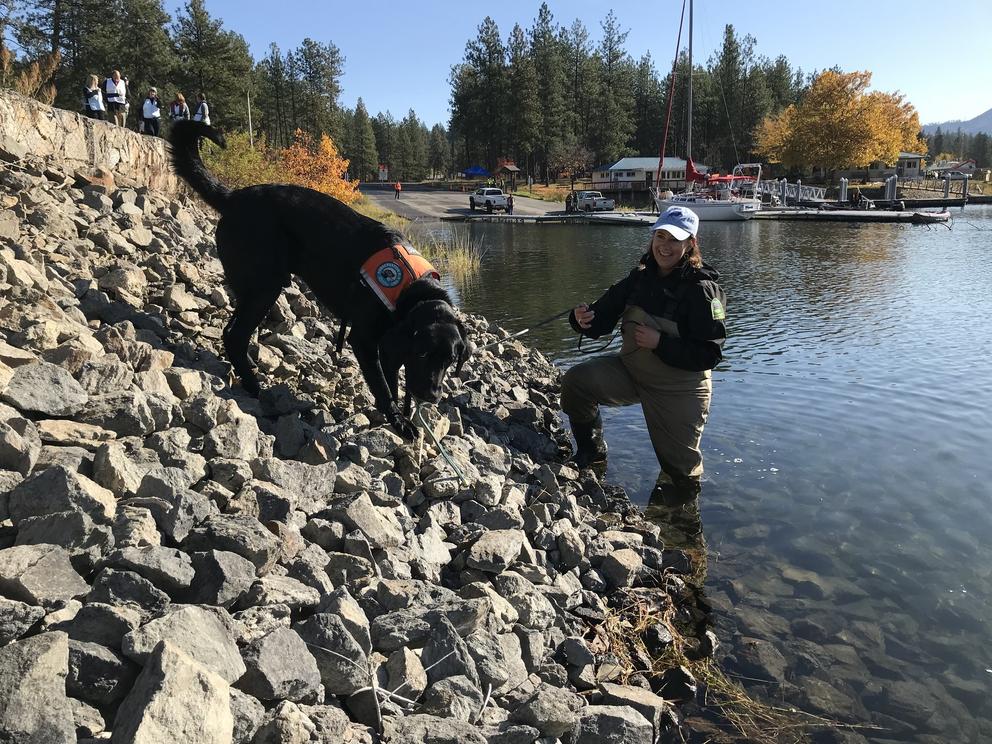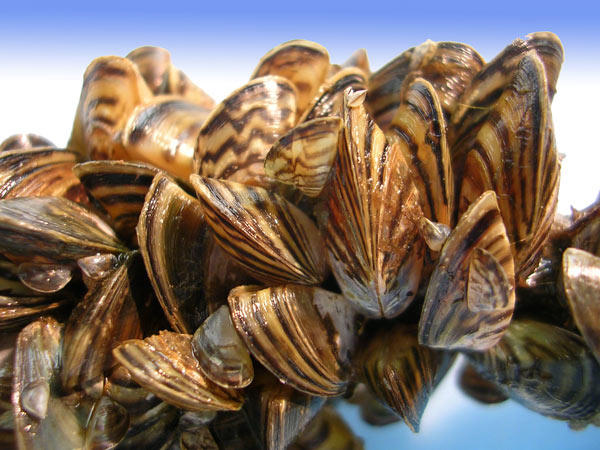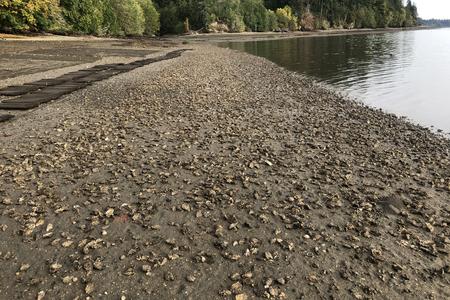“All of a sudden, my phone line started going off,” he said Thursday at noon. Anderson, who runs Fish and Wildlife's 10-person Aquatic Invasive Species Unit, says his life has been “chaos” since then.
Zebra mussels — fingernail-sized mollusks named for their striped shells — are benign in their native Black Sea and Caspian Sea ecosystems. But they are disastrous almost everywhere else. Since they were first discovered in the Great Lakes in 1986, these rapid-spawning animals have infested every watershed in the Lower 48 except the Columbia River Basin.
“There is no [chemical] way to get rid of them without destroying native species as well, so when they invade an area, it is presumably a permanent change,” says Dr. David Cowles, a biology professor at Walla Walla University, who has been keeping tabs on zebra mussels since their U.S. introduction.
Dreissenid mussels like zebra mussels and quagga mussels blanket lake bottoms, wreaking havoc on aquatic ecosystems and recreational activities such as fishing. They disrupt farms, drinking water and electricity by plugging electric and hydro utilities’ pipes, screens and filters. They even hamper shipping by covering hulls and piers, sometimes even infiltrating boats to the extent that their engines explode. They already cost U.S. taxpayers more than $1 billion in damage annually, and that excludes financial impacts to agriculture and the outdoors industry.
According to Stephen Phillips with the Pacific States Marine Fisheries Commission, the estimated annual costs of failing to prevent an invasion of these animals into the Pacific Northwest states and western Canadian provinces exceeds $500 million. Currently, states in the region spend $13.2 million a year on prevention efforts.
From Tuesday to Friday afternoon, zebra mussel sightings have popped up in Washington state, as well as Wyoming, Oregon, Colorado, Florida, Idaho, New York, Pennsylvania and Montana. “This has blown up,” Anderson says. A USGS employee said the agency has heard that at least 12 states have been affected as of Friday afternoon.
Anderson witnessed the devastation similar invasive mussels bring firsthand. After responding to a 2006 quagga mussel invasion in Lake Mead in Nevada, he returned to the lake in 2008. He discovered that cables on marina superstructures that had been less than an inch in diameter were so encased with mussels that they swelled to the width of tuna cans. “They reproduce, when I say exponentially, we're talking exponentially. I mean, beyond belief,” Anderson says. “When these things go, they go. It absolutely takes over everything.”
It took only seven years for the mussels to spread from the Great Lakes through the Mississippi River region. So Anderson knew the detection of the mussels at a Petco in Seattle would require a response where every second counts.
How did zebra mussels get here?
On Feb. 25, an aquatics department employee at a Petco store in Seattle’s Crown Hill neighborhood reported noticing something concerning in a shipment of Betta Buddy Marimo Balls, an aquarium plant often used in betta fish habitats. “Almost every shipment of these moss balls that I have unpacked for the past two months has had mussels nestled in the moss balls,” the Petco employee wrote in an incident report verified by a USGS employee. When people change the water in their aquariums, they risk flushing zebra mussels or their eggs into the ecosystem, where they can proliferate.
The pet trade has long been identified as a possible source of invasive species in Washington state. One recent report identified 58% of fish species imported via pet stores as threats to Pacific Northwest ecosystems. Petco is part of a national voluntary network of pet stores, rescue centers and veterinary clinics called Don’t Let It Loose, which warns pet owners about inadvertently releasing invasive species into the wild. But Anderson says this detection was still a surprise.
The Petco employee submitted their sighting report to USGS on Feb. 25 without photos. USGS’s Wesley Miller reached out for photos, and got a reply with them on March 2. When alerted to the issue on March 2, Anderson reached out to Seattle-based Fish and Wildlife sergeant Eric Olsen, who got to the Petco store in 20 minutes.
When Olsen arrived, he found a mussel that appeared dead. Olsen then seized 56 moss balls and delivered them to Jesse Schultz, an environmental specialist in Olympia for a visual assessment. Pulling apart the samples, they found at least 12 more mussels that appeared to be dead.
“We need to continue as if they're alive because there could be velagers [microscopic larvae] or other things,” Anderson says. The state enacted a rapid response protocol, and sought out consultants Cameron Lange and Steve Wells to do secondary assessments that evening, as well as environmental DNA testing.
On Wednesday, the team thought the moss ball threat might still be isolated to Western states. But a follow-up alert from the USGS sent nationwide helped U.S. Fish and Wildlife Service and state officers elsewhere find zebra mussels in Petcos and PetSmarts as far away as Florida.
An hour later, Petco issued a nationwide recall of the moss balls and removed them from shelves; PetSmart did, too, Anderson says, though the company has not posted any recalls or press releases to its website as of Friday afternoon. The product’s three U.S. distributors have halted sales, turned over the moss balls they have in stock and are decontaminating their tanks.
An investigation found that the moss balls are wild-harvested in Ukraine, where zebra mussels are native; and have likely been distributed throughout the U.S. by two companies in Florida and one in Gardena, California. The mussel found in Seattle came from the California distributor.
Anderson says Petco has been responsive, and the agency is not pursuing enforcement against the company right now. Trafficking could be classified as a Class C felony.
“This was an inadvertent mistake,” Anderson said during a Friday media call.
“We are working closely with regulatory authorities, our vendor partners and our own veterinary staff on appropriate next steps, including proper handling and disposal of any affected product and proactively contacting our customers to provide information and resources on how to responsibly collect and dispose of them at home, if necessary,” said Petco’s Sarah Di Fede via email Thursday.
Local Petco store employees declined to comment.
The silver lining, Anderson says, is that the incident has created a lot of dialogue between the state and Petco that wasn’t previously in place, setting up avenues for responsiveness in the future.
“You would never have seen this response to a species that isn't as high risk as zebra mussels. People are scared about this [and] very concerned when you have national chains like Petco and PetSmart who are pulling the product off the shelf willingly so quickly. It's just an indicator of the risks that we face with this species,” says the state Fish and Wildlife Department’s Allen Pleus.
It’s unclear how many moss balls have been sold in Washington state, but Bush says the department has learned that the California distributor said it has been shipping about 100,000 moss balls nationally every two weeks for months, if not years. It’s unclear when mussels started showing up in the products. “We have an untold number of potentially contaminated Marimo balls out into the world,” says Justin Bush, executive coordinator of the Washington Invasive Species Council.
With all shipments of the moss balls stopped, WDFW and its partners are focusing on consumer outreach.
“We have to assume that there's millions of them out there. And we're not gonna be able to round up millions of them [ourselves],” Anderson says.
They’re developing protocols for disposal of the moss balls for consumers able to bring them back to Petcos and Petsmarts; and trying to spread the word about how to neutralize them at home, either by boiling or freezing them.
Walla Walla University’s Cowles called his local Petco to warn them about the issue, and visited his local Petsmart to purchase its brand of moss balls on Thursday. Examining them under a dissecting microscope, he found baby mussels approximately 1.25 to 1.5 millimeters long.
“It took some careful picking through the moss balls … to find them,” he says, noting that both Petco and PetSmart were very receptive to him when he explained the problem as a member of the public.
All things considered, the state is lucky that the mussels haven’t yet been detected in the water.
“If this was mussels in the water someplace, we’re still unprepared,” Anderson says. The state has a rapid response protocol for waterborne mussel detections, but it isn't a complete solution. Boats are primary ways invasive species travel across the country, and the state Fish and Wildlife agency runs a boat inspection program that attempts to head off that effort. But there are only two checkpoints (soon to be three) in a state with 31 entry routes, Anderson notes.
That means the public plays a large role in preventing invasions. It was a member of the public that reported this mussel to USGS. “It’s just like Asian giant hornet being detected,” Bush says. “There are a lot of experts looking for these things. But there’s an infinite number of pathways that can move these problems, and we really need everyone’s help to just say something if they spot it.”
The risk factors
Anderson says the risks of a zebra mussel invasion in the Columbia River Basin are especially high. “I'm not minimizing the Mississippi River, but we are actually the river basin that has the most at stake,” Anderson says.
Zebra mussels create havoc by weaving colonies out of themselves in such dense clusters that they physically block key water passageways — all of which have drastic implications for hydropower, irrigation and drinking water. “They shut down water intake, period,” Anderson says.
There are 29 federal hydro projects in the basin; dated studies estimate each facility would each spend $25 million annually to keep zebra mussel infestations from causing blips in power delivery from clogged facilities.
Given that there are about 100 irrigation districts in Washington and plenty of municipalities pulling water from the Columbia River and its tributaries, an infestation could compromise many communities’ water facilities and agricultural needs.
“These things will affect the pipes, the pumps, everything from the intake facility all the way to the spigot going out in the farmer's fields,” Anderson says.
In 1989, a mussel infestation left the town of Monroe, Michigan, without water for three days after it clogged a water intake. In 2018, an infestation left residents of Austin, Texas, showering in water that smelled like “rotten trash” as mussels decayed in the water systems.
Ecologically, zebra mussels and their quagga mussel cousins destabilize food chains by filtering out algae and plankton that other species depend on for nutrition at an astounding pace. Cowles says they can dogpile onto native freshwater mussels by the hundreds, causing them to choke or starve to death.
Many invasive species get their big break to colonize new water bodies by hitching rides on boats, so ramped-up boating inspections and movement limitations would make it hard to float different lakes and rivers in a short period of time. “You can’t put your watercraft in Lake Wenatchee one weekend, then come home and put it in your local lake,” Bush says.
Samuel Chan, a watershed health and aquatic invasive species specialist at Oregon Sea Grant who works on cross-state invasive species issues, notes that one of the biggest infrastructure concerns is data centers, of which there are many in the basin. The centers, which are key for computer cloud storage, require massive heating and cooling systems that draw on the river. “If mussels impact the plumbing systems that provide cooling, data centers will be impacted and see pretty severe implications,” Chan says.
The potential ecosystem impacts are grim for salmon as well. If zebra mussels were to colonize salmon bypass facilities like fish ladders, zebra mussels will cut up salmon and steelhead traveling upstream toward their birthing grounds, leaving abrasions that hurt salmon mortality and their ability to spawn.
But an even bigger cause of death would occur among juvenile salmon attempting to navigate bypass pipes on their way downstream.
“If the insides of those pipes were covered with sharp zebra mussel shells, it would literally turn those bypass for the smolts into Cuisinarts,” Anderson says.
The Army Corps of Engineers is currently working on a study to estimate the costs of keeping fish passage clear of mussels, in the event of infestation.
“It doesn't just affect a person that fishes or a person that hunts,” Anderson says. He foresees a future with higher energy, water and food costs, with the maintenance fees to slough mussels from hydroelectric dams and intake valves passed onto consumers. “This literally would have an impact on every Washington citizen.”
Update: This article was updated at 11:05 a.m. on March 8 to reflect new information from USGS provided March 8 about the timeline of the incident report, and was updated on March 24 at 9:30 a.m. to clarify the Lake Mead infestation involved genetically similar quagga mussels.







